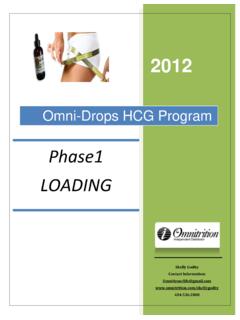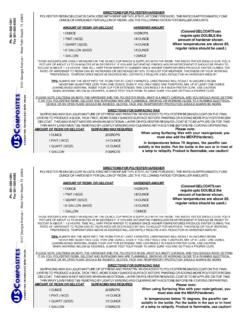Transcription of NEW ZEALAND DATA SHEET 1. PRODUCT NAME (travoprost …
1 Internal Document code 1 Duo180118iNZ NEW ZEALAND DATA SHEET 1. PRODUCT NAME DuoTravTM ( travoprost and timolol ) Eye Drops 2. QUALITATIVE AND QUANTITATIVE COMPOSITION DuoTrav Eye Drops contain a combination of travoprost and timolol maleate (equivalent to timolol ). Excipient with known effect Polyquaternium-1 (POLYQUADTM) as a preservative. For the full list of excipients, see section 3. PHARMACEUTICAL FORM Eye drops, solution. 4. CLINICAL PARTICULARS Therapeutic indications Reduction of elevated intraocular pressure in patients with open angle glaucoma or ocular hypertension for whom single agent therapy provides insufficient intraocular pressure reduction.
2 Dose and method of administration Recommended dosage for adults (including the elderly) Instil one drop of DuoTrav Eye Drops once daily at about the same time each day in the conjunctival sac of the affected eye(s). DuoTrav Eye Drops should not be given more than once daily because travoprost is most effective at this dosage. If there is inadequate response to DuoTrav Eye Drops consideration should be given to using the individual agents with timolol dosed twice daily. If more than one topical ophthalmic PRODUCT is being used, the eye drop products should be administered at least five minutes apart. Switching to therapy with DuoTrav Eye Drops When substituting another ophthalmic antiglaucoma agent with DuoTrav Eye Drops, discontinue the other agent and start the following day with DuoTrav Eye Drops.
3 Contraindications DuoTrav Eye Drops are contraindicated in patients with a known hypersensitivity to travoprost , timolol or any of the excipients listed under Section DuoTrav Eye Drops are also contraindicated in pregnant women or women attempting to become pregnant (See Section Fertility, pregnancy and lactation, Pregnancy). Reactive airway disease including bronchial asthma, a history of bronchial asthma, or severe chronic obstructive pulmonary disease. Sinus bradycardia, sick sinus syndrome, including sino-atrial block, second or third degree atrioventricular block, overt cardiac failure or cardiogenic shock. Special warnings and precautions for use Not for injection or oral ingestion.
4 Internal Document code 2 Duo180118iNZ Cardiovascular/respiratory reaction Like other topically applied ophthalmic agents, DuoTrav may be absorbed systemically. Due to the beta-adrenergic component timolol , the same types of adverse reactions seen with systemic beta-blockers may occur including aggravation of Prinzmetal angina, aggravation of severe peripheral and central circulatory disorders, bradycardia and hypotension. In patients with cardiovascular diseases ( coronary heart disease, Prinzmetal's angina and cardiac failure) and hypotension, therapy with beta-blockers should be critically assessed and therapy with other active substances should be considered.
5 Patients with cardiovascular diseases should be monitored for signs of deterioration of these diseases and for adverse reactions. Patients with severe peripheral circulatory disturbance/disorders ( severe forms of Raynaud's disease or Raynaud's syndrome) should be treated with caution. Respiratory and cardiac reactions, including death due to bronchospasm in patients with asthma and rarely death associated with cardiac failure have been reported following administration of timolol . Cardiac failure should be adequately controlled before treatment. Anaphylactic reactions While taking beta-blockers patients with a history of atopy or a history of severe anaphylactic reaction to a variety of allergens may be more reactive to repeated challenge with such allergens, whether accidental, diagnostic or therapeutic.
6 In addition, such patients may be unresponsive to the usual doses of adrenaline used to treat anaphylactic reactions. Concomitant therapy timolol may react with other drugs (see Section Interactions with other medicinal products and other forms of interactions). The effect on IOP or the known effects of systemic beta-blockade may be exaggerated when DuoTrav Eye Drops is given to patients already receiving an oral beta-blocking agent. The response of these patients should be closely monitored. The use of two topical beta-blockers or topical prostaglandins is not recommended. The use of DuoTrav Eye Drops may be considered in patients who require both timolol and travoprost , but it is unknown whether patients who are adequately controlled with timolol given twice daily plus travoprost given once daily will be as well controlled with DuoTrav Eye Drops given once daily.
7 DuoTrav Eye Drops should not be used to initiate therapy. Additional effects of beta-blockade Beta-blockers should be administered with caution in patients subject to spontaneous hypoglycaemia or to diabetic patients (especially those with labile diabetes) who are receiving insulin or oral hypoglycaemic agents. Beta-blockers may mask the signs and symptoms of acute hypoglycaemia. Therapy with beta-blockers may mask certain symptoms of hyperthyroidism and abrupt withdrawal of therapy may precipitate a worsening of symptoms. Therapy with beta-blockers may aggravate symptoms of myasthenia gravis. Surgical anaesthesia Beta-blocking ophthalmological preparations may block systemic beta-agonist effects Internal Document code 3 Duo180118iNZ of adrenaline.
8 The anaesthesiologist should be informed when the patients is receiving timolol . Ocular effects travoprost may gradually change the eye colour by increasing the number of melanosomes (pigment granules) in melanocytes. Before treatment is instituted patients must be informed of the possibility of these changes. Unilateral treatment can result in permanent heterochromia. The long term effects on the melanocytes and any consequences thereof are currently unknown. The change in iris colour occurs slowly and may not be noticeable for months to years. It may be permanent. The change in eye colour has predominantly been seen in patients with mixed coloured irides, blue-brown, grey-brown, yellow-brown and green-brown; however, it has also been observed in patients with brown eyes.
9 Typically, the brown pigmentation around the pupil spreads concentrically towards the periphery in affected eyes, but the entire iris or parts of it may become more brownish. After discontinuation of therapy, no further increase in brown iris pigment has been observed. Periorbital and/or eyelid skin darkening and deepening of the eyelid sulcus have been reported in association with the use of travoprost . Eyelash changes occurred in over a third of patients treated with DuoTrav Eye Drops. These changes include: increased length, thickness, pigmentation, and/or number of lashes. There is no experience of DuoTrav Eye Drops in inflammatory ocular conditions, inflammatory, neovascular, angle-closure or congenital glaucoma and only limited experience in open-angle glaucoma of pseudophakic patients and in pigmentary glaucoma.
10 Although not reported during pivotal clinical trials with DuoTrav Eye Drops, macular oedema, including cystoid macular oedema, has been reported during treatment with prostaglandin F2 analogues. These reports have mainly occurred in aphakic patients, pseudophakic patients with a torn posterior lens capsule or anterior chamber lenses, or in patients with known risk factors for macular oedema. DuoTrav Eye Drops should be used with caution in these patients. DuoTrav Eye Drops should be used with caution in patients with active intraocular inflammation, as well as patients with predisposing risk factors for uveitis. Choroidal detachment has been reported with administration of aqueous suppressant therapy ( timolol , acetazolamide) after filtration procedures.

















